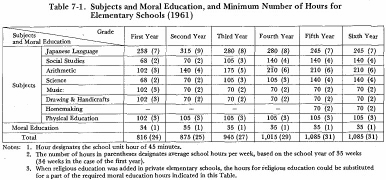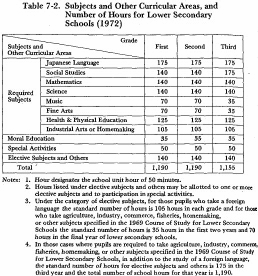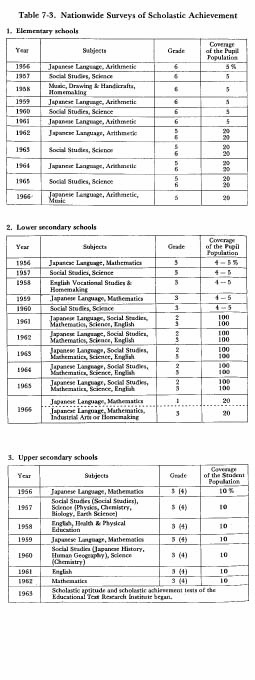- 現在位置
- トップ > 白書・統計・出版物 > 白書 > JAPAN'S MODERN EDUCATIONAL SYSTEM > 3 Revisions of the Courses of Study and the Development of Teaching Method
3 Revisions of the Courses of Study and the Development of Teaching Method
The Courses of Study, which were published by the Ministry of Education in 1947 and considered to be the standard for curricula throughout the school system, were replaced by the1951 Courses of Study while the Occupation was still in force. With the end of the Occupation period, however, it was generally accepted that the school curricula should be thoroughly reviewed and revised in such a way as to make them more suitable for the Japanese educational system and the 1958 Courses of Study were announced. Proceeding thus system-wide revision, however, attention was given to revising the controversial social studies subject. Social studies, it will be recalled, had combined morals (shushin), civics (kotmin), geography, and history into a single subject and was acclaimed as the core of the new curricula in educating students for democracy. The deletion of a subject specifically devoted to moral education had been criticized by various groups. In response to this, in 1951 the Ministry of Education published a handbook of moral education. In 1955 the Ministry revised the entire social studies curriculum, but the basic aim of this subject has continued to be the cultivation of democratic ideas and practices.
Based on investigations launched by the Ministry of Education into the effectiveness of the curricula as they were being taught after the end of the Occupation period and on there commendations in 1958 of the Curriculum Council, the 1958Course of Study for Elementary Schools and the. 1958 Course of Study for Lower Secondary Schools were both announced in October, 1958, and respectively implemented in April, 1961 (See Table 7-1.), and in April, 1962. According to a revision of Regulations for the Enforcement of the School Education Law issued in August, 1958, the curricula, which had previously been divided into two categories - subjects and extracurricular activities - , were to be reclassified into four categories: subjects, moral education, extracurricular activities, and school events and others. Points which were given particular emphasis included strengthening of moral education; improvement of the geography and history education offered in the curriculum of the social studies subject; placing greater stress on the acquisition of basic scholastic skills, especially in Japanese language and arithmetic (or mathematics); and upgrading of the content of subjects such as arithmetic (or mathematics) and science (rika) in order to expand the scientific and technological education offered in the schools.
The decade of the 1960s was a period of rapid economic growth and technological change. To keep pace with the times, it became apparent that a major revision of the school curricula would be necessary. Thus, the new Courses of Study were announced for the elementary schools in July, 1968, and for the lower secondary schools in April, 1969, to be implemented respectively, in April, 1971, and in April, 1972 (See Table 7-2.). The basic aims of this revision were twofold: one, to reorient the curricula in such a way as to enable them to reflect the rapidly changing and increasingly complicated social structure; and two, to redesign the curricula in a uniform and cohesive manner in such a way as to enable pupils to acquire basic knowledge and master technical skills, to promote health and physical fitness, and to foster the development of good judgment, creativeness, emotion, and will.
A further accommodation to the changing times was the decision to make the standard number of hours for the school year flexible according to the prevailing circumstances of a particular region or school. Moreover, the curricula were once more reclassified, this time into three categories: subjects, moral education, and special activities.
Table 7-1. Subjects and Moral Education, and Minimum Number of Hours for Elementary Schools (1961)

Table 7-2. Subjects and Other Curricular Areas, and Number of Flours for Lower Secondary Schools. (1972)

Concurrent with these changes in the educational content of the schools, there was steady improvement in the supporting structure. The Ministry of Education showed particular interest in new developments in the field of teaching methods and learning process devices, such as the development of teaching machines, Research schools were designated by the Ministry to promote innovation in these areas.
In order to acquire the data necessary to reform the curricula and teaching methods and to improve the physical conditions of5chools, the Ministry or Education, as early as 1956, had started surveys of the scholastic achievement of pupils in the last year of elementary and lower and upper secondary schools by a sampling process. Moreover, every year from 1961 to 1965, surveys of the scholastic achievement of all pupils in the last two years of lower secondary schools were undertaken in order to obtain extensive data on the scholastic abilities of pupils as they completed the final two years of compulsory education (See Table 7-3.). Unfortunately, the compilation of data of this nature by the Ministry was opposed by the Japan Teachers' Union, which feared that the results would be used by the national government to evaluate teachers or to further its own control over education.
In 1964 the first phase of an international survey on educational attainment in twelve countries, including Japan, was completed in the area of mathematics education and the high marks achieved by Japanese pupils in the examination stimulated much international interest in Japanese education.
Table 7-3. Nationwide Surveys of Scholastic Achievement 1. Elementary schools 2. Lower secondary schools 3. Upper secondary schools

お問合せ先
(C)COPYRIGHT Ministry of Education, Culture, Sports, Science and Technology
-- 登録:平成21年以前 --